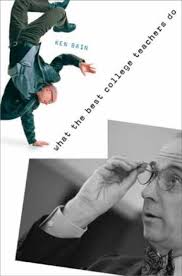

Based on interviews and other information gathering such as observations, colleague/student comments, and course materials from 63 "excellent" college teachers in the USA, Ken Bain presents his conclusions on how the best college teachers create exceptional learning in their college courses that stimulates and challenges their students.
"Exceptional learning" (p.189) is defined in two dimensions: intellectual development and personal development. Intellectual development includes acquiring subject knowledge, learning how to learn independently, reasoning from evidence, employing abstract concepts, engaging in conversations/communication in speaking and writing about that field, asking sophisticated questions, and developing the habits of mind to continue to employ those abilities. Personal development includes 1) understanding one's self (history, emotions, dispositions, abilities, limitations prejudices, assumptions, passions, 2) understanding what it means to be human, 3) developing a sense of responsibility to one's self and others, including moral development and the ability to exercise compassion and understand and use one's emotions.
I think that list above covers what I aim for. I hadn't thought about the "personal development" side of exceptional learning very deeply before, but feel that I aim to help my students with their personal development through the liberal arts academic English courses I teach, especially when I am able to include a sufficient amount of personal choice and reflective writing in the learning curriculum so that students can explore their interests and create meaningful learning experiences for themselves.
The book can serve as a good introduction to what good college learning should be, and has much value there, especially for college professors who may have never studied recent learning theory and methods and are stuck in traditional lecture and test-giving models of college courses that fail to stimulate intellectual engagement.Unfortunately, for teachers who are already conducting teaching according to the "learning-centered" principles that the book introduces, it lacks well-developed specific examples of good practices, and primary goes on and on about abstract descriptions of what good teachers seem to do, supported only by a few rather vague quotes. When some interesting practice was mentioned, I kept wishing for more details, or at least a reference to some documentation that could shed more light on how to carry it out.
Some interesting practices that I want to explore (more) in my teaching are:
1.Writing a syllabus as an inspiring list of invitations to a learning environment and promises for discovery and personal development based on adherence to community guidelines, rather than requirements with penalties. What abilities can you learn/develop in this course? Why are those abilities important? (Who gives a damn?) How can we work together to make that happen? How will we assess whether you are being able to develop those abilities? How will we assess whether the course is optimally helping you develop those abilities?
2. Write a book like this on "What the best college English teachers in Japan do?" employing research methods similar to his. Has this already been done? Who might be interested in working with me on this?
3. Students must learn to judge their own quality of work. Best grading is to some extent based on a final reflective essay that explains what they learned or developed and how they want to improve further.
4. Create an archive of student research results that other students can see (
Richardson case, 1999 Texas University). ICU really, really needs this. Students each year are doing very inspiring work, but their work is rarely ever made available to peers or the world. We need a system for publishing student work--some kind of balance between requiring all students to publish and only publishing student work that is exceptional--publishing work that student/teacher/peers have worked together to polish and engage readers should be a standard practice for this learning community, especially in the end of the first year + second year of ELP, as it should be in the major courses as well. And how about senior theses? Are those available easily online, and why not?
5. Expect personal development from students - mention this explicitly as a learning objective - compassion, find new passions, responsibility, understanding oneself, human society, and one's community.
6. Ask an inpartial third party consultant (Director? Staff member? Another student?) to come into the class around mid-term (and also at the end, possibly) to ask students their honest views of the learning in the course and any suggestions or expectations.
7. Building a convincing teaching portfolio each term - Class materials, observations, student reflections/evaluations, quality of student work. I guess my blog can act as this, but what would help organize the process more effectively?
Nice ideas to explore and experiment with in the new term. Good stuff.



































